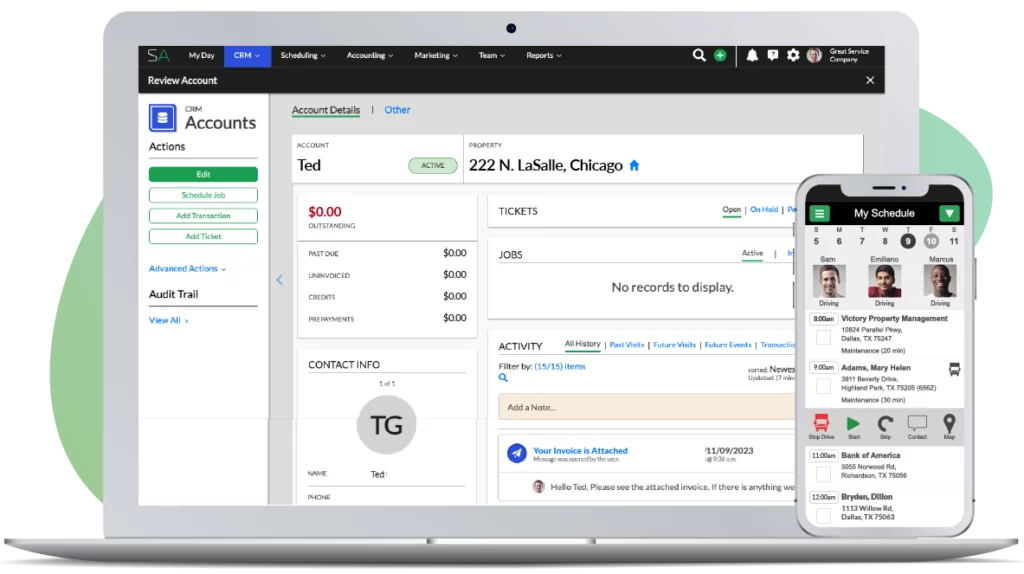In this video, Martha shares her success in how to motivate employees to perform high quality work consistently.
Jonathan: I’ve got another interview for you. It’s with Martha. It’s one of five. Don’t discount her. She’s in the residential cleaning space. She has multiple locations. What an incredibly difficult business. Could you imagine sending your team into your clients’ homes everyday, and everything they did was nitpicked, and every time they lost something, you were accused of stealing it? Or, they were accused of stealing it? She’s got a lot of great advice and she’s got a lot of value. Check out what she has to say.
Had an opportunity to get to know you over the last several years, and one thing that I’ve absolutely observed, and I feel like others in the industry that I know that are friends with you all sing the same song, and that is that you’re an expert on building a system around quality within your company. For a number of reasons, I think you’re an expert at this. With that being said, can you give us some tips and tricks, and I know you’ve worked on this for years, can you tell us what you’ve learned about achieving a high level of quality in a company, and in a service coming in, and how do you actually, how do get that to manifest itself? How do you create a company with really high quality?
Martha: Sure. I was just thinking of really why I have created such a program around quality, and I guess what I would say is that you know me, I’m pretty laid back.
Jonathan: You are.
Martha: I’m not actually a very detailed person. However, I don’t like getting quality complaints. I don’t like the staff having them, nor losing clients. I really wanted to develop a system that could maintain itself, and that didn’t require me, you know, having a thumb on people all the time. What I’ve done is set up a program that allows me to track numbers. I do like data, and I do like to make decisions based on hard, cold facts. We base our quality around customer satisfaction, so it involves, you have to start with a survey. You’ve got to ask the client how satisfied they are, and we send out a survey after every job.
Now, I’m in the maid service world, so most of our clients are every other week. It’s part of a process. When a prospective client calls us, and we’re selling our service, one of our selling points is actually our quality program. We tell them that up front. We’ll tell them how we’re different. We’ll tell them about how you’ll receive a survey after every cleaning. We tell them that we have performance based programs, and because of these programs, our employees have buy in, and want to do a good job. Like, they’re not going to want to get a three out of four, because many of their benefits don’t happen until a four.
We also try to educate the prospective client that everything’s a learning lesson, and that we have very few punitive processes, so not to be afraid to tell us what they really think, because we can’t fix it if we don’t know. Anyway, we have that process. Now, if we have somebody that doesn’t want a survey every time, we have a mechanism that we don’t send it. That’s very few of our clients, actually. I think it’s because of education. We tell them up front that’s what we’re doing.
We send a survey, we get the survey back, and then we have ways that we can track things. I use a software now that can do that for me, but for many years, I took those survey results, and the office staff plugged them into an Excel spreadsheet. It took a lot of manual tracking, but it was worth it to me, because I wanted that data. We would average it out every month. We would watch our trends. We definitely watched it as a company, per employee, per team, everything. We watched that. We have something called a client watch list. We have employee rankings where they’re actually ranked according to their quality scores or their customer satisfaction scores. Then, of course, we’ve got a process for complaints. We call it the service recovery program, which I actually got from a colleague.
If we get a complaint, we have a process to where we have the employee sign off on a written form, and we send an apology note, and then we actually do an inspection at the home the next visit. If it’s a major complaint, then we go a little bit further. We may even send some type of a gift certificate, or something with the apology note. Then, we’re going to inspect that cleaning the next two visits. That’s how we do that. Then, of course, we use it on the opposite side to track high performance. Like I say, we have bonus programs based around high performers, and they’ll get, it may be paid days off, it may be cash, whatever. We have those programs in place.
Jonathan: You mentioned … Oh, go ahead. I’ll let you keep going.
Martha: No, no. Go ahead.
Jonathan: Okay, well you mentioned the watch list a minute ago, and I wanted to ask you a little bit more about that. Is the watch list an example of clients that might not have given a top review to the employee, and therefore you, and correct me if I’m wrong, but then they end up on this list where the company’s hyper aware of who might be at risk, and they’re getting a little extra attention? How does that work? For example, if they show up on a list, what’s the procedure?
Martha: Okay, so our watch list, and again, this is just part of the software, it’s programmed to watch for a score drop. You have some clients that’ll never give you a four. They just don’t believe in it. They’re going to always give you a three, and that doesn’t mean anything bad for them. What we watch is for trends. If they gave us a four before, but now we’re getting a three, that means something. I like that because they didn’t complain, so they didn’t really fall on your radar. However, you had a score drop, so they’ll show up on our client watch list. On the client watch list, of course there’s failing scores, and then we actually have a tab that we watch that is for no responses.
No responses aren’t good either. We do … Our goal is to keep our response rate above sixty-five percent. Now, that’s really pretty unheard of in most companies. I will say that when we started surveying, gosh, four to five years ago, we started in the high twenties. We have worked it. I mean, like I say, it’s just ingrained in our clients, it’s ingrained in our employees, and then in our office staff. If we’re not getting a response, then we give them three days to respond, and if they aren’t responding, we’re actually making phone calls. If we don’t ever get a response from somebody, we’re out doing a quality inspection, because we’re afraid there is a reason they’re not telling us what they think.
Jonathan: That’s pretty interesting. Sixty-five percent sounds really high to me. I’m guessing that if I heard you correctly in the very beginning, you’re setting the tone at the very beginning of the relationship, sort of during the courting phase, before they’ve even become a client. You’re setting the tone that, “This is how we’re different than everyone else, because we have this process by which we measure our team, and we hold them accountable. They really are bought in and want to perform.” One, you’re selling yourself in that way, but then you’re also, and correct me if I’m wrong, you’re also setting the tone that as a client of Dusting Divas, here’s the expectation we have, and maybe you use different wording, but we then ask you to talk to us, and the way you talk to us is by filling out these surveys. Is that a true assessment of what’s happening? That at the beginning of that process, you’re telling them about the survey, and telling them that you need them to do this as … Okay, that makes a lot of sense.
Martha: We basically tell them, and you know, we try to be informal and casual, but when we’re talking to them, we will kind of joke and say, “If you don’t answer our survey, you’ll probably be getting a call from us or an email.” We also explain to them up front that it’s an email survey, it’s a one click survey. All they have to do is click excellent, good. There’s a little explanation for each rating, but that’s all they have to do. Now, they have the opportunity to give us more feedback than that. They have the opportunity to give comments, and if they’re positive comments, we actually have a way that we can just, with a click of a button, take it from the survey comment, and push it to our website as a testimonial.
Jonathan: That’s pretty cool. That’s cool.
Martha: I love that because, right, it’s like I’m hitting our page. I’m updating our webpage everyday. The testimonials are from yesterday, so that’s awesome. I like that.
Jonathan: I like the simplicity of your survey. I’ve seen it, and it’s pretty, which is actually, the design is really good, but on top of that, I like the just ridiculous simplicity. You can actually get someone to do that, because it’s so simple and so easy to do.
Martha: Right. Exactly.
Jonathan: I also like that you do the follow up call if they don’t do it, because several things come to mind. One, you’re actually living what you said you would do at the very beginning when they were still a prospect. You’re actually following through. If you told them or joked with them that, “Hey, if you don’t do it, we’re going to call you,” then you actually do it. I think that sets a really good tone for the company. Then also, if they get a call or two from you, every time they see that survey, they’re going to think, “Okay, I’ve got to do this, otherwise they’re going to call me.” You train behavior. I love that.
Martha: Exactly. We do. We do train them. We joke about that. We’re like, “Oh, they’re new. We got to train them.”
Jonathan: Yup. I love that. That’s good. I guess, maybe before I move on to asking you another question, can you kind of give me a … I know this is really successful because of everything I’ve heard about it, and others I’ve talked to that are using your process that you’ve now created, and a lot of other people are now using it. Can you give me an example of what maybe your world looked like prior to this, and then now what it looks like? What was the difference that you’ve experienced inside your business that sold you on continuing to invest in this?
Martha: When we started, like I say, we had a response rate in the upper twenties, low thirties. Just that alone, I felt like, “I really don’t know what the majority of my clients think of our service.” Our scores were also … My minimum score at that time was a three point three out of four. I had people not making that. I did. I had people not making that. Now, years later, really … My published minimum score is a three point five out of four. However, bonuses don’t start till three point six five. I have very few people who don’t get bonuses in my company. It’s the same scoring, it’s the same survey as I had when I started.
We still lose people. We still have people who no matter what don’t respond. It’s certainly fewer. I’ll tell, if somebody says they’re quitting us due to money, the first thing I go look at is were they returning their survey? What were they scoring us? Because I’m not going to believe them unless I see that they were giving us glowing, you know, not even just a four, but comments, and so forth. I have data to go by, and I know where employees stand. I know which clients to worry about.
Jonathan: I like it. I would imagine that this creates a little bit of a social pressure internally. If you bring a new individual onto the team, they’ve never experienced this in anybody else’s company, so this is going to be a new concept to them. If they see everyone else on the team trying to get the best score possible and take phenomenal care of the client, I’ve got to imagine it creates social pressure where they then too want to … They don’t want to be left out. They don’t want to be the person with the low score. Does that take place inside the company? Is that social pressure a real thing?
Martha: It really does.
Jonathan: Okay.
Martha: It does.
Jonathan: That’s pretty awesome.
Martha: Like I say, each employee has their own user sign in process. Each employee, I don’t make them look up their scores. However, I can ask somebody in any given day what their quality score is, and they know. I’m telling you, Bill, if they got any type of a negative comment or score from somebody, they’re in the office going, “Why did Mrs. Smith give me a two,” and, “You need to contact her, because I don’t know why I got a two.” I mean, they’re on it. I ask them … We had our company picnic the other day, and I said, “So do you guys like to be able to look up your scores? Do you like that you have control of that now?” Because we always shared it with them, but there’s a delay, and it was time intensive.
Hands down, even just a look in their eyes, they just popped and said, “Yes.” Because they don’t feel like we’re hiding things from them anymore. I love it because they’re accountable. Now, I’m sitting here talking about a program that I developed, so I want to say that it can be done. I absolutely did build it by using Excel spreadsheets. You can do it, it’s the same thing. It’s just the employees don’t have the access that they have now. It was certainly more time intensive. You can do everything I’m talking about.
Jonathan: By automating it and simplifying it with technology, you’re, at the end of the day, saving a lot of money over using a spreadsheet because you’re saving time and payroll. You’re letting the people that might have had to do all the data in Excel, now they can go do more important, bigger things around the company, that make the company money instead of data entry. It’s just a no brainer in my mind.
Martha: Exactly.
Jonathan: That’s awesome.



